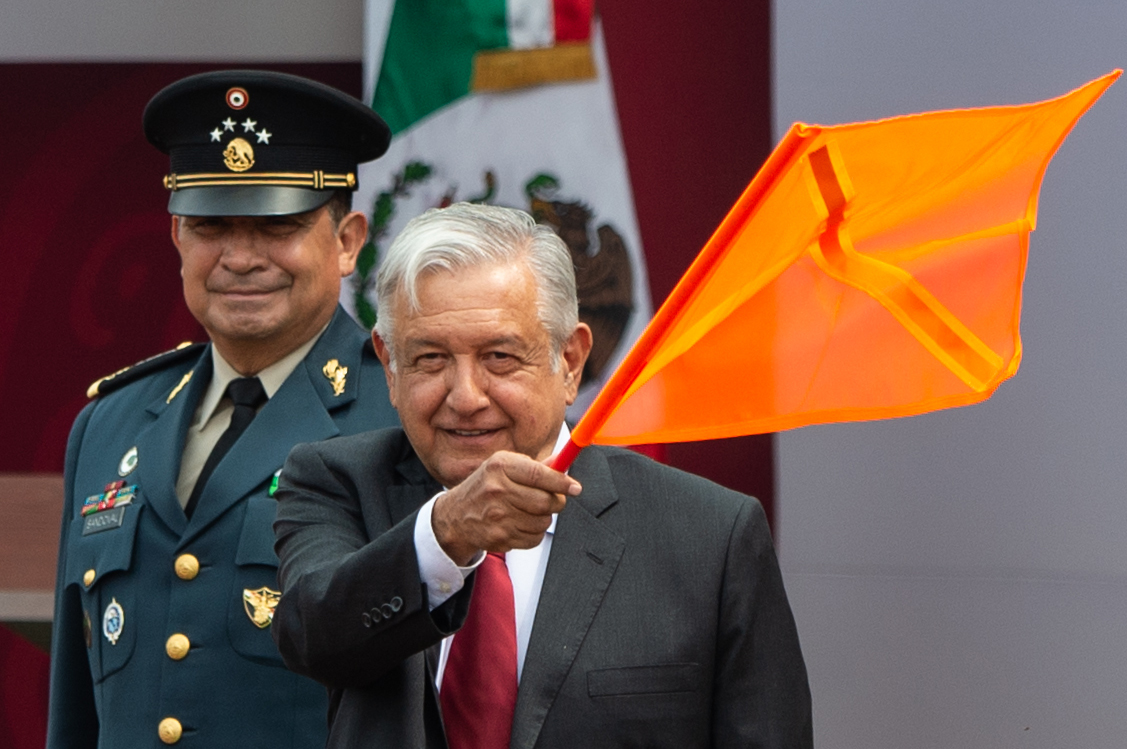
by Sofia MISELEM / Sylvain ESTIBAL
Agence France-Presse
MEXICO CITY, Mexico (AFP) – For a groundbreaking ceremony, there was suspiciously little ground broken as President Andres Manuel Lopez Obrador symbolically inaugurated work on a new Mexico City airport — a pet project analysts warn could go badly wrong.
Smiling and waving an orange flag, the anti-establishment leftist stood before a line of heavy construction equipment last Monday, declaring work was officially under way to turn the Santa Lucia military air base into a second airport for the sprawling Mexican capital.
But there was no sign of that from the bulldozers, which stood by silently throughout — and could stay that way for some time.
The new airport faces heavy turbulence, aviation experts say.
The biggest problem is the ring of mountains that surrounds Mexico City, limiting the routes for take-off and landing, and making it a logistical nightmare to operate two separate airports, according to critics.
“Some people say, ‘There are other cities with more than one airport.’ That’s true, but they don’t have Mexico City’s orography,” said Mexican pilot Angel Jimenez, a 58-year-old veteran with 22,000 hours of flying experience.
“We’re surrounded by a system of mountains shaped like an inverted horseshoe. The only flight pattern for ascents and descents is via the north. There will be a huge amount of air traffic,” he told AFP.
Airport wars
On top of that, Lopez Obrador, who took office in December, has infuriated many people by canceling another airport project that was launched by the previous government and was already one-third complete.
The sleek new airport in the Texcoco district was meant to completely replace the current airport, which is aging poorly and handled nearly 48 million passengers last year — despite an official capacity of 32 million.
But Lopez Obrador called the $13-billion project a “bottomless pit” rife with corruption. He canceled it after holding a controversial referendum that had no independent oversight and was plagued by irregularities.
In doing so, he essentially thumbed his nose at the business world — including the fifth-richest person on Earth, Mexican telecoms magnate Carlos Slim, who had a major stake in the new airport and had warned that canceling it would amount to “canceling the economic growth of the country.”
Lopez Obrador is promising an “austere” alternative: continue using the current airport and easing its load by converting the Santa Lucia base into a second civilian airport.
The repurposed base is to be called the Felipe Angeles airport, in honor of a hero of the Mexican Revolution who fought alongside Pancho Villa before being executed by firing squad in 1919.
It will cost around $4 billion, the government estimates — though canceling the Texcoco airport will also hit the country with around $5.2 billion in sunk costs, according to its calculations.
Experts wary
However, that is assuming everything goes according to plan — and so far, there is room for doubt.
The company hired to carry out feasibility studies for the new airport system, France’s ADP, says it will mean reconfiguring the airspace over Mexico City.
“The studies have just begun, and no definitive decisions have been made so far,” ADP said in an email.
However, operating two airports will mean “reassessing how the city’s airspace is organized,” with “new approach procedures” for aircraft, it said.
It said Lopez Obrador’s goal of opening the first portion of the project in 2021 was “ambitious,” but feasible if construction work is accelerated.
Miguel Angel Valero, a Mexican pilot and security official with the International Civil Aviation Organization, warned there was no good option for operating two airports in the metropolitan area of more than 20 million people, which sits 2,200 meters (7,200 feet) above sea level and has mountains rising well beyond that.
“It’s not impossible to have two airports, but it involves a high degree of complexity. It will be impossible to have simultaneous approaches and take-offs, and the margin of error for air-traffic controllers and pilots will be minimal,” said Valero, the former head of the Mexican pilots’ association.
“For the operation to be safe, it will have to be inefficient,” he told AFP.
The Paula problem
Adding to Lopez Obrador’s headaches, engineers discovered just before the ground-breaking ceremony that the planned flight path for the Santa Lucia airport is partially blocked by a 240-meter-tall hill dubbed Paula.
The hill, which was not taken into consideration in initial studies for the project, could force engineers to change the orientation of the airport’s runways — adding to the final bill.
Critics had a field day with the glitch on social media, posting pictures of “solutions” including a hill perforated by a runway or whose slope served for take-offs.
Valero said the problem goes deeper than that.
“It’s not just Paula, it’s the whole Guadalupe mountain chain” surrounding the capital, he said.
“They’re betting on a new satellite-based technology (for approaches), which is very precise but also very complex. You need a lot of technology, very modern planes and pilot training. It’s no panacea.” Agence France-Presse







